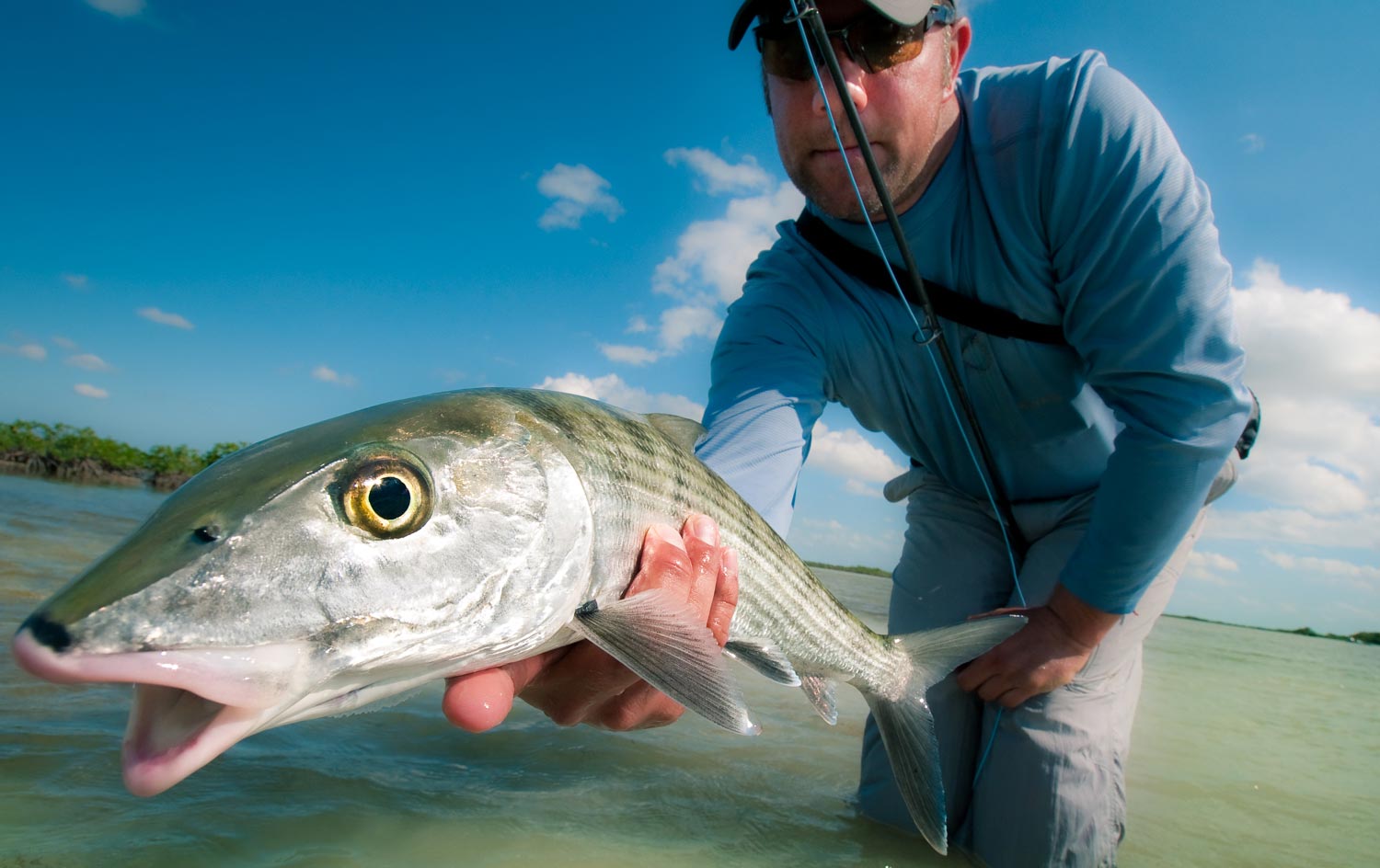By Louis Cahill
Saltwater fly-fishing is condition dependent, and conditions often change without warning. That’s why I carry two fly rods.
Your strategy for presenting a fly to bonefish can change radically depending on conditions. Bonefishing is always challenging, but not always for the same reasons. That’s what keeps it fun. Having the right setup for the conditions really helps you overcome the challenges, so let’s look at those challenges and how to be prepared for whatever mother nature throws at you.
The most decisive factor in any flats fishing is wind. Most anglers dread fishing on a windy day, but they miss that wind when it’s gone. Making a good cast and turning your leader over in wind can be a real challenge, but the wind gives you an advantage, too. Wind disturbs the surface of the water, making it less likely that your presentation will spook the fish. This allows you to drive a powerful cast into the wind, if you have a fly rod and line that are up to the task.
On days when there is no wind, bonefish can be unbelievably spooky, leaving anglers frustrated as fish run for cover at their false casting. On days like that, your ultra-fast fly rod and front loaded line are a liability, not an asset. So what is the bonefish angler to do? Well, my answer is carry two rods.
My common quiver consists of two 8-weights.
One for windy conditions and one for calm. Each of these rods is paired with a fly line which will perform in these given conditions. That way, no mater what happens, I’m ready. These two rods look very similar under casual observation but they perform very differently.
Windy day setups
Your windy day rod needs to be firm and fast. It’s totally ok for this rod to be a little heavier. We aren’t looking for the kind of recovery rate that comes from light materials, but rather from stiffness. A couple of my favorite rods for this application are the Thomas and Thomas Solar in the premium category and the Echo EPR, which is a bargain in the mid-priced category.
These powerful rods perform best when paired with a front-weighted line which is a bit over weighted. My line of choice is the Airflo Tropical Punch. This line is 3/4 over traditional line weights and has an aggressive front taper to turn over in the wind. It has a low stretch core, ridge texture for more effective line shooting and a long rear taper for better control. Paired with the right fly rod, it gives you a remarkable advantage in the wind.
Calm day setups
For calm days, I like a lighter weight fly rod with a slightly deeper load. A more technical fly rod will deliver delicate presentations, even at a distance. A rod made of light weight, high modulus graphite will still have a fast recovery rate, and generate line speed, without being brutish. The Scott Meridian and Sage X are great choices in this category. I personally choose the Meridian.
I pair this rod with a more technical, longer belly line like the RIO Bonefish or Airflo Super DRI Bonefish. These lines have thinner, lighter heads which land softly on the water. They perform beautifully when carrying a long line in the air and they pick up off the water easily and quietly. They also cast a lighter shadow, which makes a huge difference when fish are spooky.
Can’t afford two rods?
I totally respect that. Here’s another option, which isn’t a bad compromise. Carry a rod that is a good all-around rod, and take two reels loaded with different lines. Rods like the Orvis Helios 2 and G Loomis Asquith pair well with different lines and perform in both windy and calm conditions. It will take you a little longer to change lines, but it’s not a bad compromise.
Dialing in your gear to match the conditions can make a big difference in your angling success. Ask your local fly shop to let you try a couple of different rod and line combinations. When you find the setups you like, take them out for some practice sessions in both windy and calm conditions. I think you’ll find you’re a much more effective angler when the time comes, no matter what the conditions.
Louis Cahill Gink & Gasoline www.ginkandgasoline.com hookups@ginkandgasoline.com Sign Up For Our Weekly Newsletter!

On one occasion in Ambergris Belize, where the winds whipped to 20 plus knots, I’ve actually thrown a 10 weight, clear line to very spooky bonefish. You couldn’t approach these fish by foot. without sinking in the muck, and the boat could only approach to 70-80 ft away from the school. I managed 3 decent sized bonefish that day, and would not have been successful without the heavy 10 weight. Sometimes conditions call for drastic measures. Don’t forget to lengthen the leader as well to shy bonefish.
That’s a great idea for permit as well. However, the angler has to remember that each setup will fell different and it is worth throwing a few blind casts to get calibrated every time you change from one setup to the other. You might have your ‘calm day’ setup and casting dialed in, but your ‘windy day’ setup and casting will undoubtedly feel and cast different. Take a few minutes to get to know the setup before you you see tails and nervous water.
I find most of the articles I read to be very informative
This morning the winds are 25km and I’m sitting it out on Long Island bahamas
Guess I need to take a new approach to wind conditions as comments make good sense
Thanks for the good input
D
can’t afford two rods, so you suggest an Asquith or Helios? thats a good one!
Both great rods. That’s a personal preference.